International Trade: Risks of Payment and Incoterms Analysis
VerifiedAdded on 2022/10/13
|8
|2195
|122
Essay
AI Summary
This essay examines the risks involved in international trade, focusing on different payment methods such as cash in advance, letters of credit, and open accounts, from the exporter's perspective. It highlights the advantages and disadvantages of each method, including the potential for delayed payments, non-payment, and the impact on brand value. The essay also explores the factors influencing the selection of Incoterms for both importers and exporters, considering shipping routes, costs, and control over the freight process. It discusses the problems associated with relying on Incoterms, such as a lack of flexibility and the prevalence of fraudulent practices, ultimately aiming to provide a comprehensive understanding of the complexities involved in international trade.
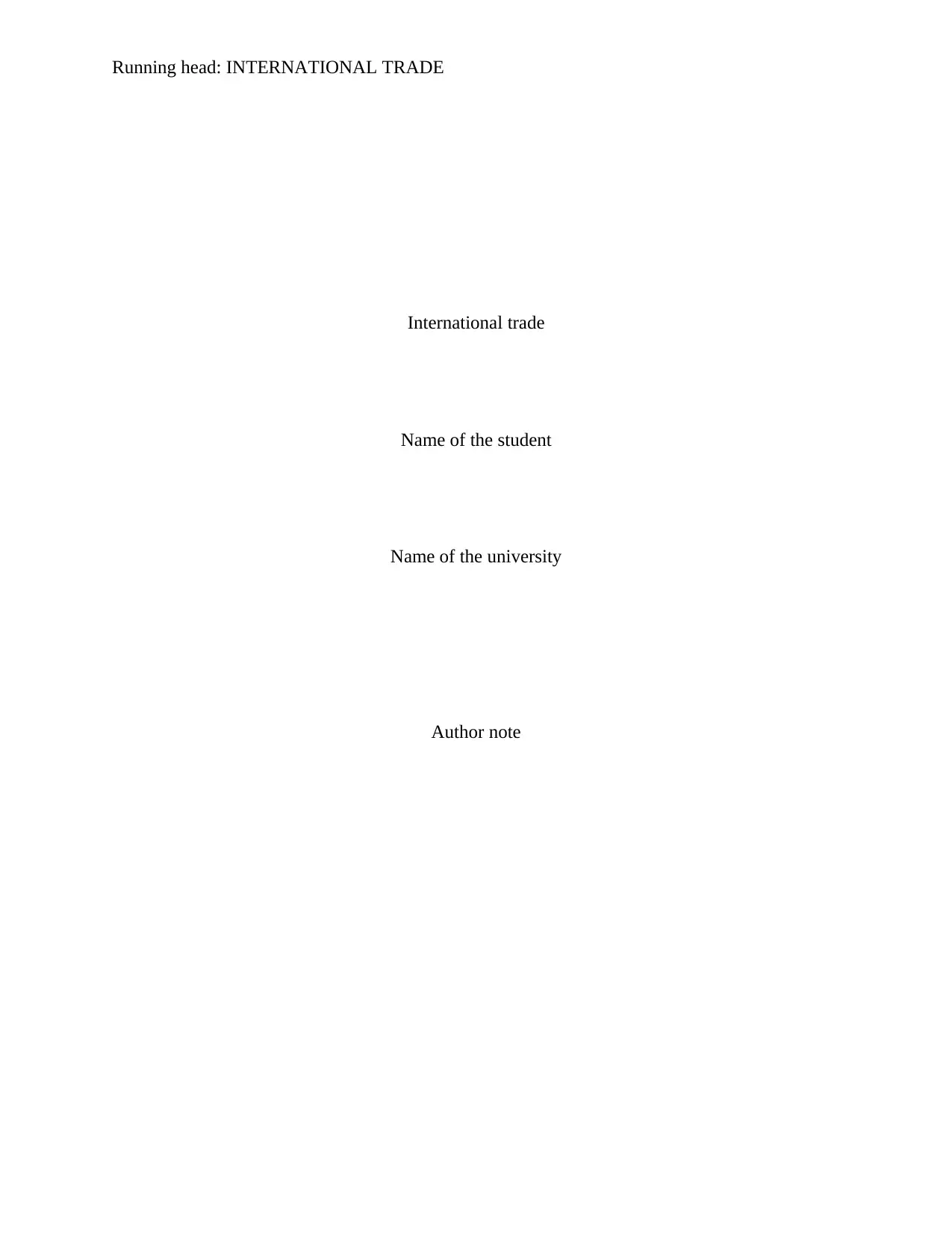
Running head: INTERNATIONAL TRADE
International trade
Name of the student
Name of the university
Author note
International trade
Name of the student
Name of the university
Author note
Paraphrase This Document
Need a fresh take? Get an instant paraphrase of this document with our AI Paraphraser
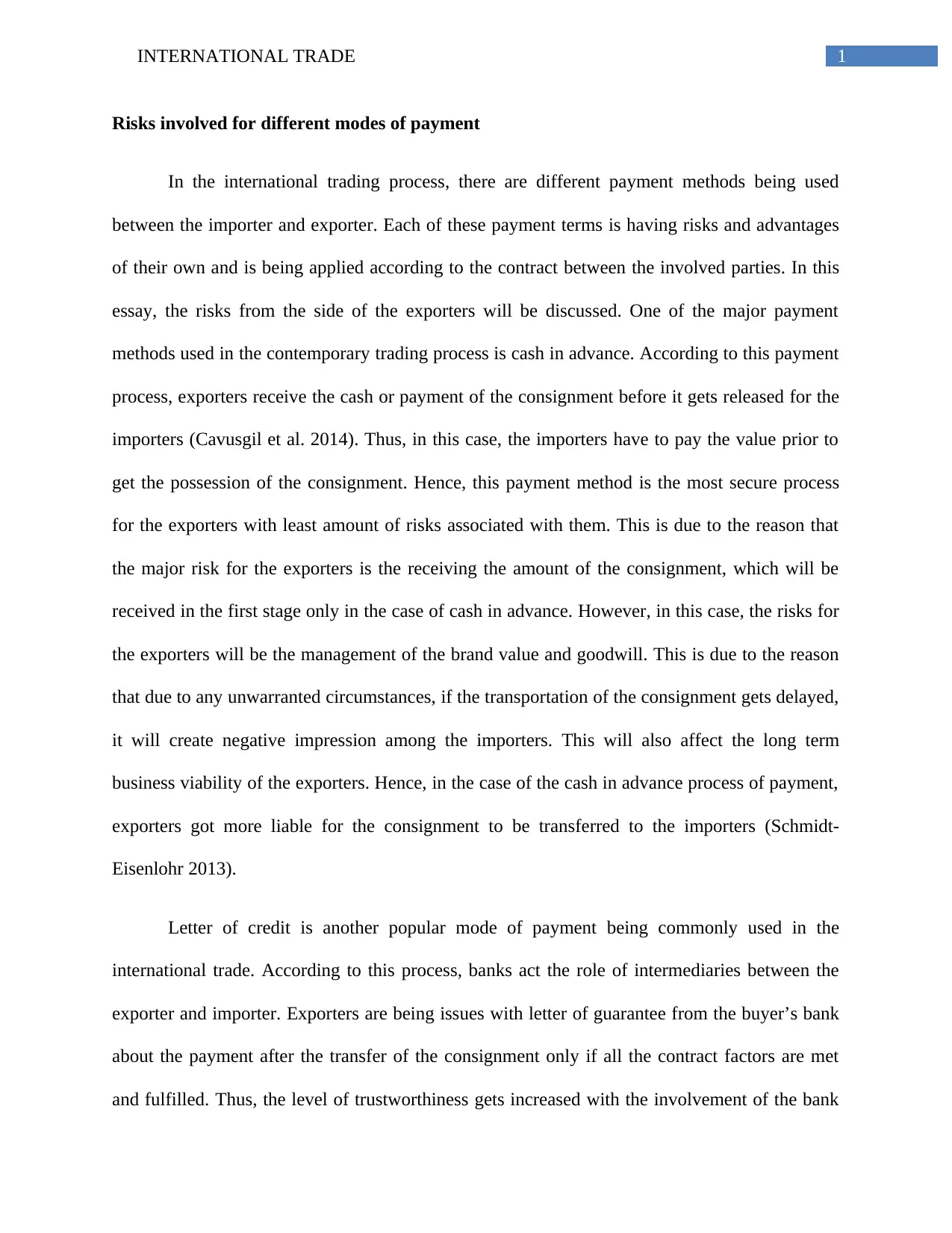
1INTERNATIONAL TRADE
Risks involved for different modes of payment
In the international trading process, there are different payment methods being used
between the importer and exporter. Each of these payment terms is having risks and advantages
of their own and is being applied according to the contract between the involved parties. In this
essay, the risks from the side of the exporters will be discussed. One of the major payment
methods used in the contemporary trading process is cash in advance. According to this payment
process, exporters receive the cash or payment of the consignment before it gets released for the
importers (Cavusgil et al. 2014). Thus, in this case, the importers have to pay the value prior to
get the possession of the consignment. Hence, this payment method is the most secure process
for the exporters with least amount of risks associated with them. This is due to the reason that
the major risk for the exporters is the receiving the amount of the consignment, which will be
received in the first stage only in the case of cash in advance. However, in this case, the risks for
the exporters will be the management of the brand value and goodwill. This is due to the reason
that due to any unwarranted circumstances, if the transportation of the consignment gets delayed,
it will create negative impression among the importers. This will also affect the long term
business viability of the exporters. Hence, in the case of the cash in advance process of payment,
exporters got more liable for the consignment to be transferred to the importers (Schmidt-
Eisenlohr 2013).
Letter of credit is another popular mode of payment being commonly used in the
international trade. According to this process, banks act the role of intermediaries between the
exporter and importer. Exporters are being issues with letter of guarantee from the buyer’s bank
about the payment after the transfer of the consignment only if all the contract factors are met
and fulfilled. Thus, the level of trustworthiness gets increased with the involvement of the bank
Risks involved for different modes of payment
In the international trading process, there are different payment methods being used
between the importer and exporter. Each of these payment terms is having risks and advantages
of their own and is being applied according to the contract between the involved parties. In this
essay, the risks from the side of the exporters will be discussed. One of the major payment
methods used in the contemporary trading process is cash in advance. According to this payment
process, exporters receive the cash or payment of the consignment before it gets released for the
importers (Cavusgil et al. 2014). Thus, in this case, the importers have to pay the value prior to
get the possession of the consignment. Hence, this payment method is the most secure process
for the exporters with least amount of risks associated with them. This is due to the reason that
the major risk for the exporters is the receiving the amount of the consignment, which will be
received in the first stage only in the case of cash in advance. However, in this case, the risks for
the exporters will be the management of the brand value and goodwill. This is due to the reason
that due to any unwarranted circumstances, if the transportation of the consignment gets delayed,
it will create negative impression among the importers. This will also affect the long term
business viability of the exporters. Hence, in the case of the cash in advance process of payment,
exporters got more liable for the consignment to be transferred to the importers (Schmidt-
Eisenlohr 2013).
Letter of credit is another popular mode of payment being commonly used in the
international trade. According to this process, banks act the role of intermediaries between the
exporter and importer. Exporters are being issues with letter of guarantee from the buyer’s bank
about the payment after the transfer of the consignment only if all the contract factors are met
and fulfilled. Thus, the level of trustworthiness gets increased with the involvement of the bank
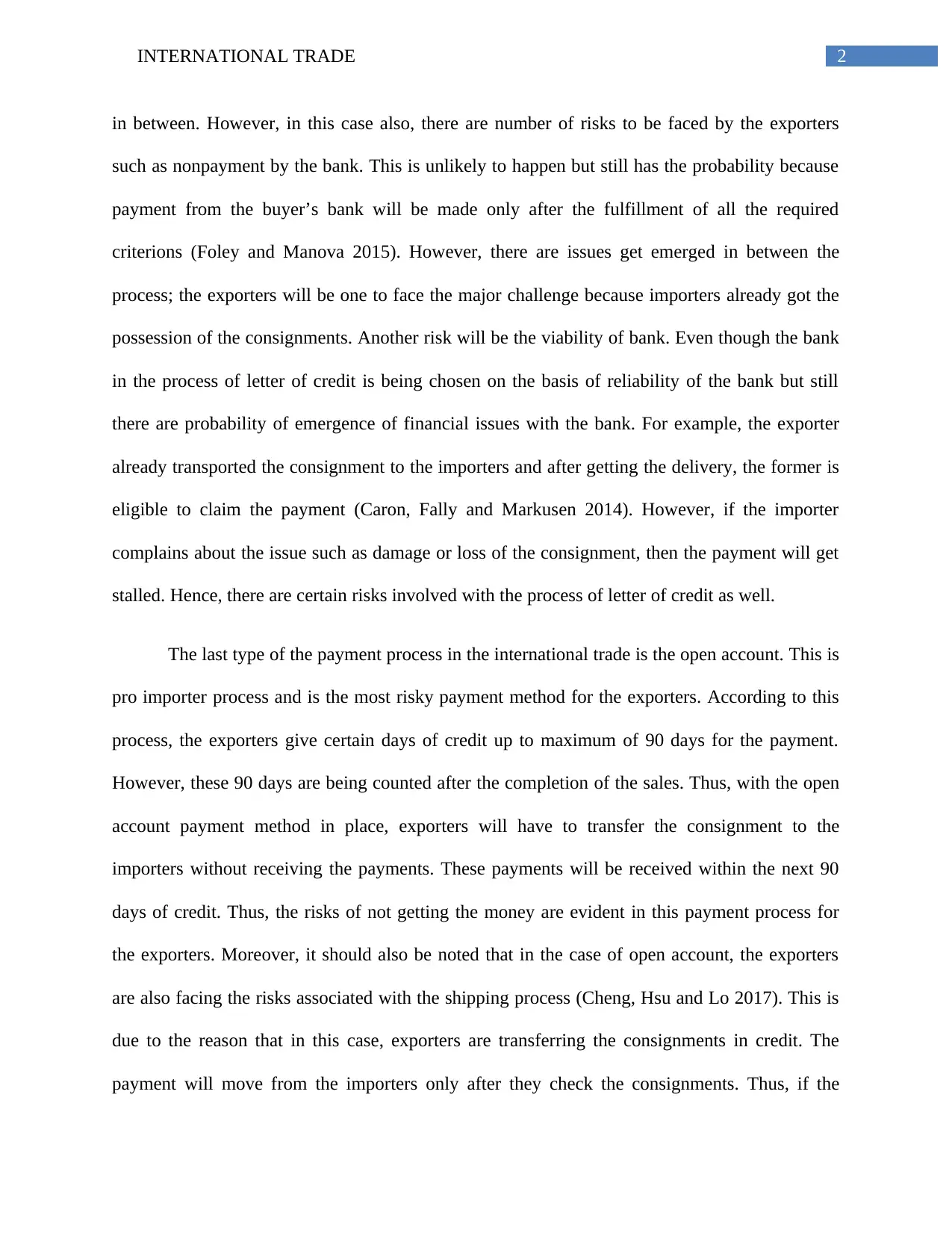
2INTERNATIONAL TRADE
in between. However, in this case also, there are number of risks to be faced by the exporters
such as nonpayment by the bank. This is unlikely to happen but still has the probability because
payment from the buyer’s bank will be made only after the fulfillment of all the required
criterions (Foley and Manova 2015). However, there are issues get emerged in between the
process; the exporters will be one to face the major challenge because importers already got the
possession of the consignments. Another risk will be the viability of bank. Even though the bank
in the process of letter of credit is being chosen on the basis of reliability of the bank but still
there are probability of emergence of financial issues with the bank. For example, the exporter
already transported the consignment to the importers and after getting the delivery, the former is
eligible to claim the payment (Caron, Fally and Markusen 2014). However, if the importer
complains about the issue such as damage or loss of the consignment, then the payment will get
stalled. Hence, there are certain risks involved with the process of letter of credit as well.
The last type of the payment process in the international trade is the open account. This is
pro importer process and is the most risky payment method for the exporters. According to this
process, the exporters give certain days of credit up to maximum of 90 days for the payment.
However, these 90 days are being counted after the completion of the sales. Thus, with the open
account payment method in place, exporters will have to transfer the consignment to the
importers without receiving the payments. These payments will be received within the next 90
days of credit. Thus, the risks of not getting the money are evident in this payment process for
the exporters. Moreover, it should also be noted that in the case of open account, the exporters
are also facing the risks associated with the shipping process (Cheng, Hsu and Lo 2017). This is
due to the reason that in this case, exporters are transferring the consignments in credit. The
payment will move from the importers only after they check the consignments. Thus, if the
in between. However, in this case also, there are number of risks to be faced by the exporters
such as nonpayment by the bank. This is unlikely to happen but still has the probability because
payment from the buyer’s bank will be made only after the fulfillment of all the required
criterions (Foley and Manova 2015). However, there are issues get emerged in between the
process; the exporters will be one to face the major challenge because importers already got the
possession of the consignments. Another risk will be the viability of bank. Even though the bank
in the process of letter of credit is being chosen on the basis of reliability of the bank but still
there are probability of emergence of financial issues with the bank. For example, the exporter
already transported the consignment to the importers and after getting the delivery, the former is
eligible to claim the payment (Caron, Fally and Markusen 2014). However, if the importer
complains about the issue such as damage or loss of the consignment, then the payment will get
stalled. Hence, there are certain risks involved with the process of letter of credit as well.
The last type of the payment process in the international trade is the open account. This is
pro importer process and is the most risky payment method for the exporters. According to this
process, the exporters give certain days of credit up to maximum of 90 days for the payment.
However, these 90 days are being counted after the completion of the sales. Thus, with the open
account payment method in place, exporters will have to transfer the consignment to the
importers without receiving the payments. These payments will be received within the next 90
days of credit. Thus, the risks of not getting the money are evident in this payment process for
the exporters. Moreover, it should also be noted that in the case of open account, the exporters
are also facing the risks associated with the shipping process (Cheng, Hsu and Lo 2017). This is
due to the reason that in this case, exporters are transferring the consignments in credit. The
payment will move from the importers only after they check the consignments. Thus, if the
⊘ This is a preview!⊘
Do you want full access?
Subscribe today to unlock all pages.

Trusted by 1+ million students worldwide
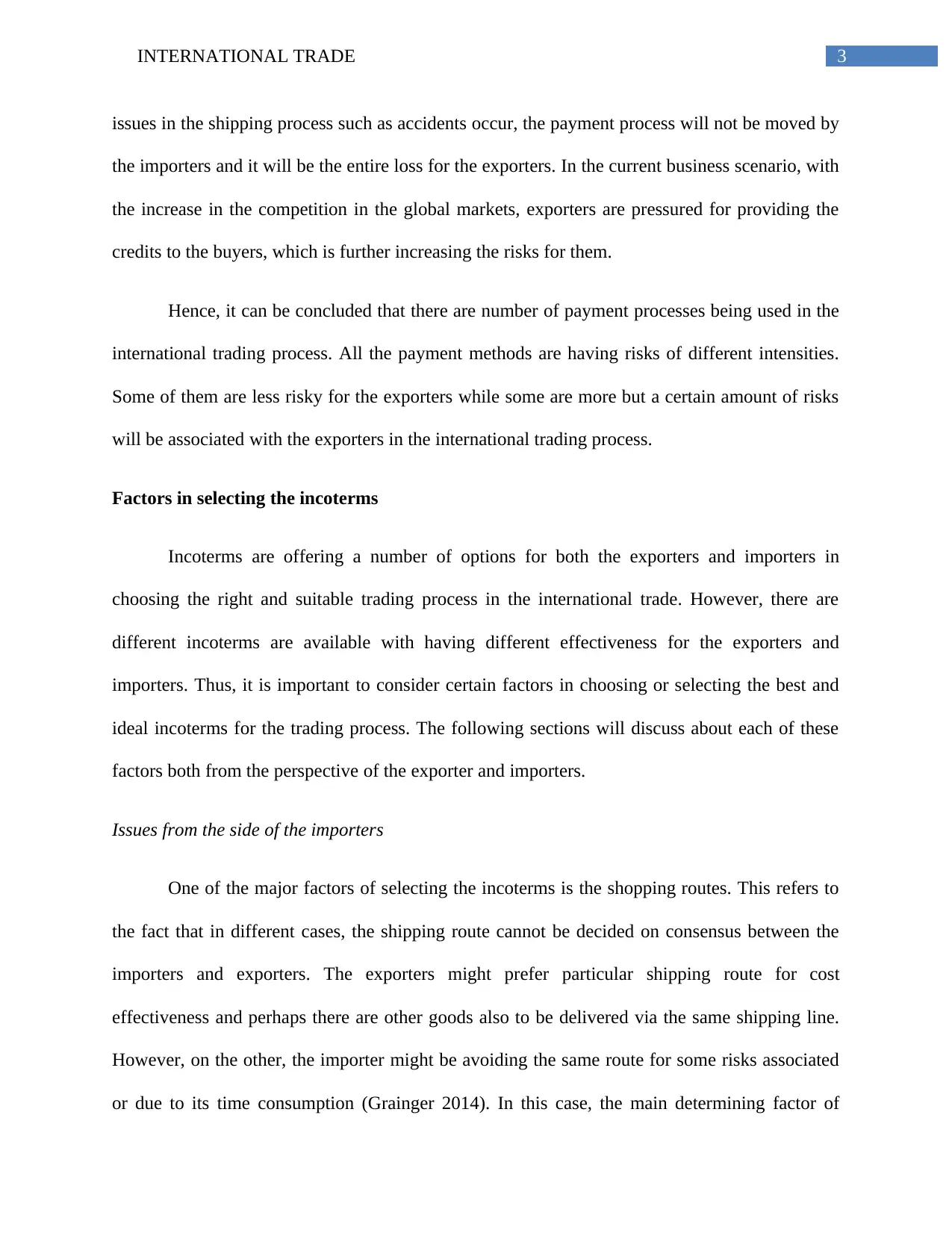
3INTERNATIONAL TRADE
issues in the shipping process such as accidents occur, the payment process will not be moved by
the importers and it will be the entire loss for the exporters. In the current business scenario, with
the increase in the competition in the global markets, exporters are pressured for providing the
credits to the buyers, which is further increasing the risks for them.
Hence, it can be concluded that there are number of payment processes being used in the
international trading process. All the payment methods are having risks of different intensities.
Some of them are less risky for the exporters while some are more but a certain amount of risks
will be associated with the exporters in the international trading process.
Factors in selecting the incoterms
Incoterms are offering a number of options for both the exporters and importers in
choosing the right and suitable trading process in the international trade. However, there are
different incoterms are available with having different effectiveness for the exporters and
importers. Thus, it is important to consider certain factors in choosing or selecting the best and
ideal incoterms for the trading process. The following sections will discuss about each of these
factors both from the perspective of the exporter and importers.
Issues from the side of the importers
One of the major factors of selecting the incoterms is the shopping routes. This refers to
the fact that in different cases, the shipping route cannot be decided on consensus between the
importers and exporters. The exporters might prefer particular shipping route for cost
effectiveness and perhaps there are other goods also to be delivered via the same shipping line.
However, on the other, the importer might be avoiding the same route for some risks associated
or due to its time consumption (Grainger 2014). In this case, the main determining factor of
issues in the shipping process such as accidents occur, the payment process will not be moved by
the importers and it will be the entire loss for the exporters. In the current business scenario, with
the increase in the competition in the global markets, exporters are pressured for providing the
credits to the buyers, which is further increasing the risks for them.
Hence, it can be concluded that there are number of payment processes being used in the
international trading process. All the payment methods are having risks of different intensities.
Some of them are less risky for the exporters while some are more but a certain amount of risks
will be associated with the exporters in the international trading process.
Factors in selecting the incoterms
Incoterms are offering a number of options for both the exporters and importers in
choosing the right and suitable trading process in the international trade. However, there are
different incoterms are available with having different effectiveness for the exporters and
importers. Thus, it is important to consider certain factors in choosing or selecting the best and
ideal incoterms for the trading process. The following sections will discuss about each of these
factors both from the perspective of the exporter and importers.
Issues from the side of the importers
One of the major factors of selecting the incoterms is the shopping routes. This refers to
the fact that in different cases, the shipping route cannot be decided on consensus between the
importers and exporters. The exporters might prefer particular shipping route for cost
effectiveness and perhaps there are other goods also to be delivered via the same shipping line.
However, on the other, the importer might be avoiding the same route for some risks associated
or due to its time consumption (Grainger 2014). In this case, the main determining factor of
Paraphrase This Document
Need a fresh take? Get an instant paraphrase of this document with our AI Paraphraser
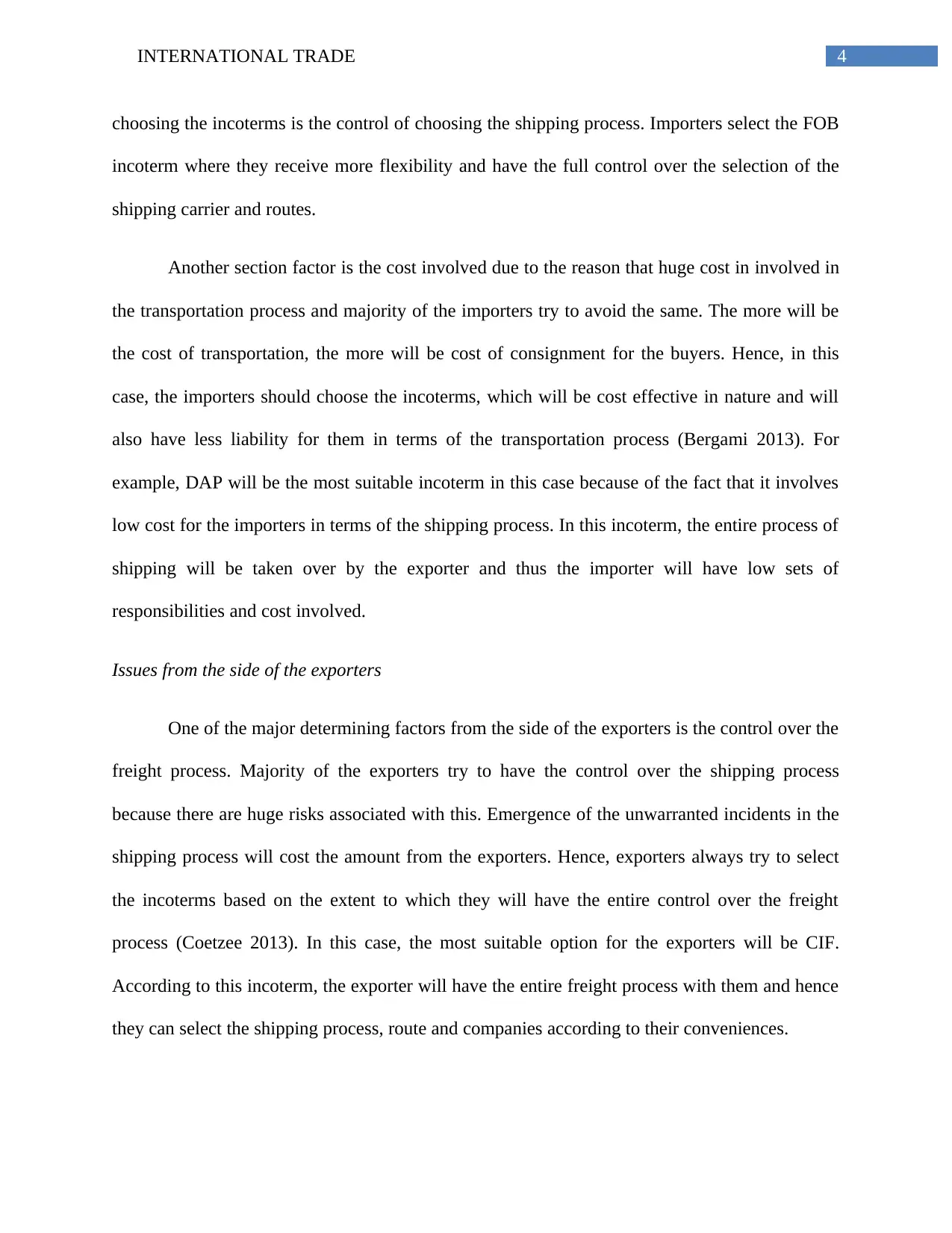
4INTERNATIONAL TRADE
choosing the incoterms is the control of choosing the shipping process. Importers select the FOB
incoterm where they receive more flexibility and have the full control over the selection of the
shipping carrier and routes.
Another section factor is the cost involved due to the reason that huge cost in involved in
the transportation process and majority of the importers try to avoid the same. The more will be
the cost of transportation, the more will be cost of consignment for the buyers. Hence, in this
case, the importers should choose the incoterms, which will be cost effective in nature and will
also have less liability for them in terms of the transportation process (Bergami 2013). For
example, DAP will be the most suitable incoterm in this case because of the fact that it involves
low cost for the importers in terms of the shipping process. In this incoterm, the entire process of
shipping will be taken over by the exporter and thus the importer will have low sets of
responsibilities and cost involved.
Issues from the side of the exporters
One of the major determining factors from the side of the exporters is the control over the
freight process. Majority of the exporters try to have the control over the shipping process
because there are huge risks associated with this. Emergence of the unwarranted incidents in the
shipping process will cost the amount from the exporters. Hence, exporters always try to select
the incoterms based on the extent to which they will have the entire control over the freight
process (Coetzee 2013). In this case, the most suitable option for the exporters will be CIF.
According to this incoterm, the exporter will have the entire freight process with them and hence
they can select the shipping process, route and companies according to their conveniences.
choosing the incoterms is the control of choosing the shipping process. Importers select the FOB
incoterm where they receive more flexibility and have the full control over the selection of the
shipping carrier and routes.
Another section factor is the cost involved due to the reason that huge cost in involved in
the transportation process and majority of the importers try to avoid the same. The more will be
the cost of transportation, the more will be cost of consignment for the buyers. Hence, in this
case, the importers should choose the incoterms, which will be cost effective in nature and will
also have less liability for them in terms of the transportation process (Bergami 2013). For
example, DAP will be the most suitable incoterm in this case because of the fact that it involves
low cost for the importers in terms of the shipping process. In this incoterm, the entire process of
shipping will be taken over by the exporter and thus the importer will have low sets of
responsibilities and cost involved.
Issues from the side of the exporters
One of the major determining factors from the side of the exporters is the control over the
freight process. Majority of the exporters try to have the control over the shipping process
because there are huge risks associated with this. Emergence of the unwarranted incidents in the
shipping process will cost the amount from the exporters. Hence, exporters always try to select
the incoterms based on the extent to which they will have the entire control over the freight
process (Coetzee 2013). In this case, the most suitable option for the exporters will be CIF.
According to this incoterm, the exporter will have the entire freight process with them and hence
they can select the shipping process, route and companies according to their conveniences.
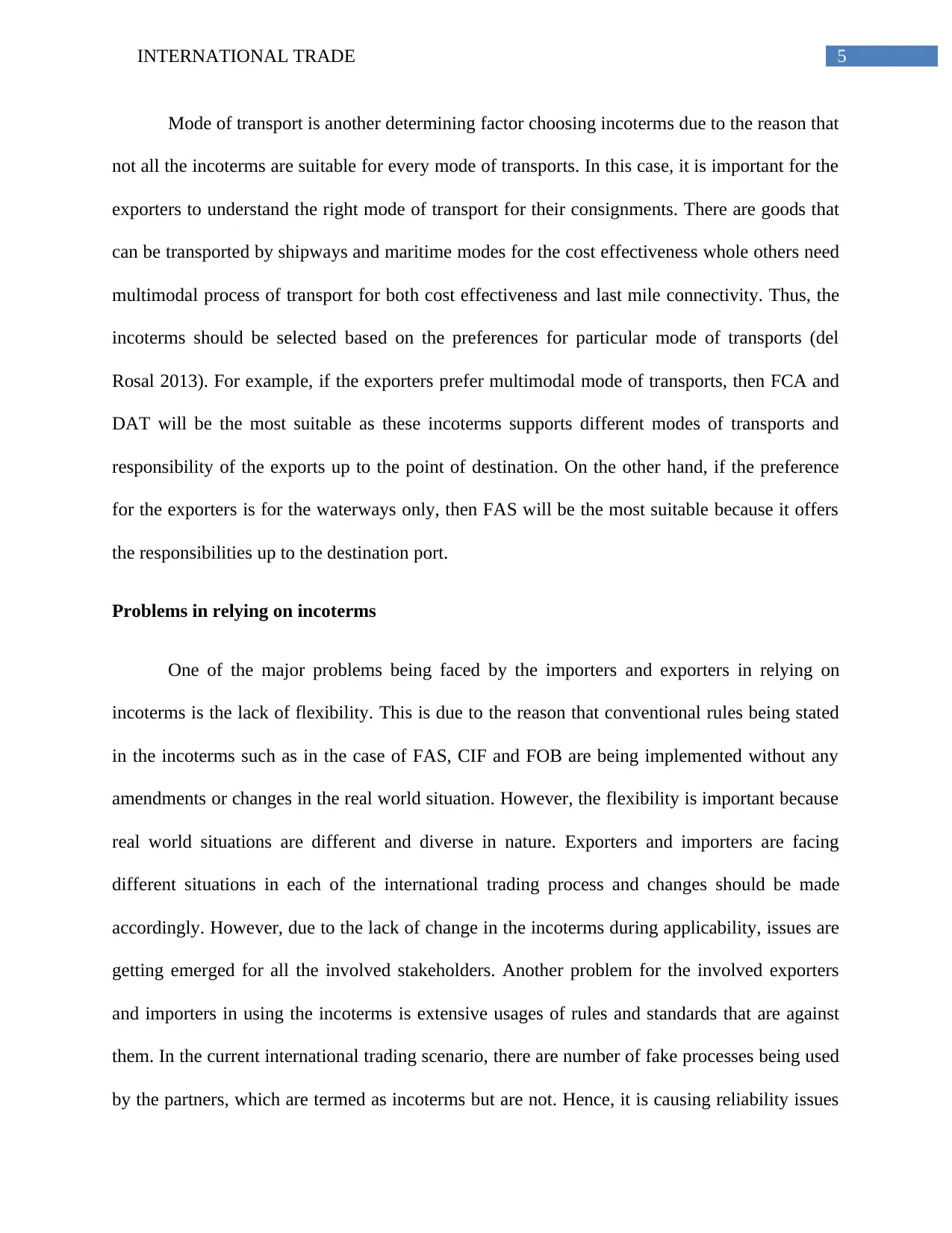
5INTERNATIONAL TRADE
Mode of transport is another determining factor choosing incoterms due to the reason that
not all the incoterms are suitable for every mode of transports. In this case, it is important for the
exporters to understand the right mode of transport for their consignments. There are goods that
can be transported by shipways and maritime modes for the cost effectiveness whole others need
multimodal process of transport for both cost effectiveness and last mile connectivity. Thus, the
incoterms should be selected based on the preferences for particular mode of transports (del
Rosal 2013). For example, if the exporters prefer multimodal mode of transports, then FCA and
DAT will be the most suitable as these incoterms supports different modes of transports and
responsibility of the exports up to the point of destination. On the other hand, if the preference
for the exporters is for the waterways only, then FAS will be the most suitable because it offers
the responsibilities up to the destination port.
Problems in relying on incoterms
One of the major problems being faced by the importers and exporters in relying on
incoterms is the lack of flexibility. This is due to the reason that conventional rules being stated
in the incoterms such as in the case of FAS, CIF and FOB are being implemented without any
amendments or changes in the real world situation. However, the flexibility is important because
real world situations are different and diverse in nature. Exporters and importers are facing
different situations in each of the international trading process and changes should be made
accordingly. However, due to the lack of change in the incoterms during applicability, issues are
getting emerged for all the involved stakeholders. Another problem for the involved exporters
and importers in using the incoterms is extensive usages of rules and standards that are against
them. In the current international trading scenario, there are number of fake processes being used
by the partners, which are termed as incoterms but are not. Hence, it is causing reliability issues
Mode of transport is another determining factor choosing incoterms due to the reason that
not all the incoterms are suitable for every mode of transports. In this case, it is important for the
exporters to understand the right mode of transport for their consignments. There are goods that
can be transported by shipways and maritime modes for the cost effectiveness whole others need
multimodal process of transport for both cost effectiveness and last mile connectivity. Thus, the
incoterms should be selected based on the preferences for particular mode of transports (del
Rosal 2013). For example, if the exporters prefer multimodal mode of transports, then FCA and
DAT will be the most suitable as these incoterms supports different modes of transports and
responsibility of the exports up to the point of destination. On the other hand, if the preference
for the exporters is for the waterways only, then FAS will be the most suitable because it offers
the responsibilities up to the destination port.
Problems in relying on incoterms
One of the major problems being faced by the importers and exporters in relying on
incoterms is the lack of flexibility. This is due to the reason that conventional rules being stated
in the incoterms such as in the case of FAS, CIF and FOB are being implemented without any
amendments or changes in the real world situation. However, the flexibility is important because
real world situations are different and diverse in nature. Exporters and importers are facing
different situations in each of the international trading process and changes should be made
accordingly. However, due to the lack of change in the incoterms during applicability, issues are
getting emerged for all the involved stakeholders. Another problem for the involved exporters
and importers in using the incoterms is extensive usages of rules and standards that are against
them. In the current international trading scenario, there are number of fake processes being used
by the partners, which are termed as incoterms but are not. Hence, it is causing reliability issues
⊘ This is a preview!⊘
Do you want full access?
Subscribe today to unlock all pages.

Trusted by 1+ million students worldwide
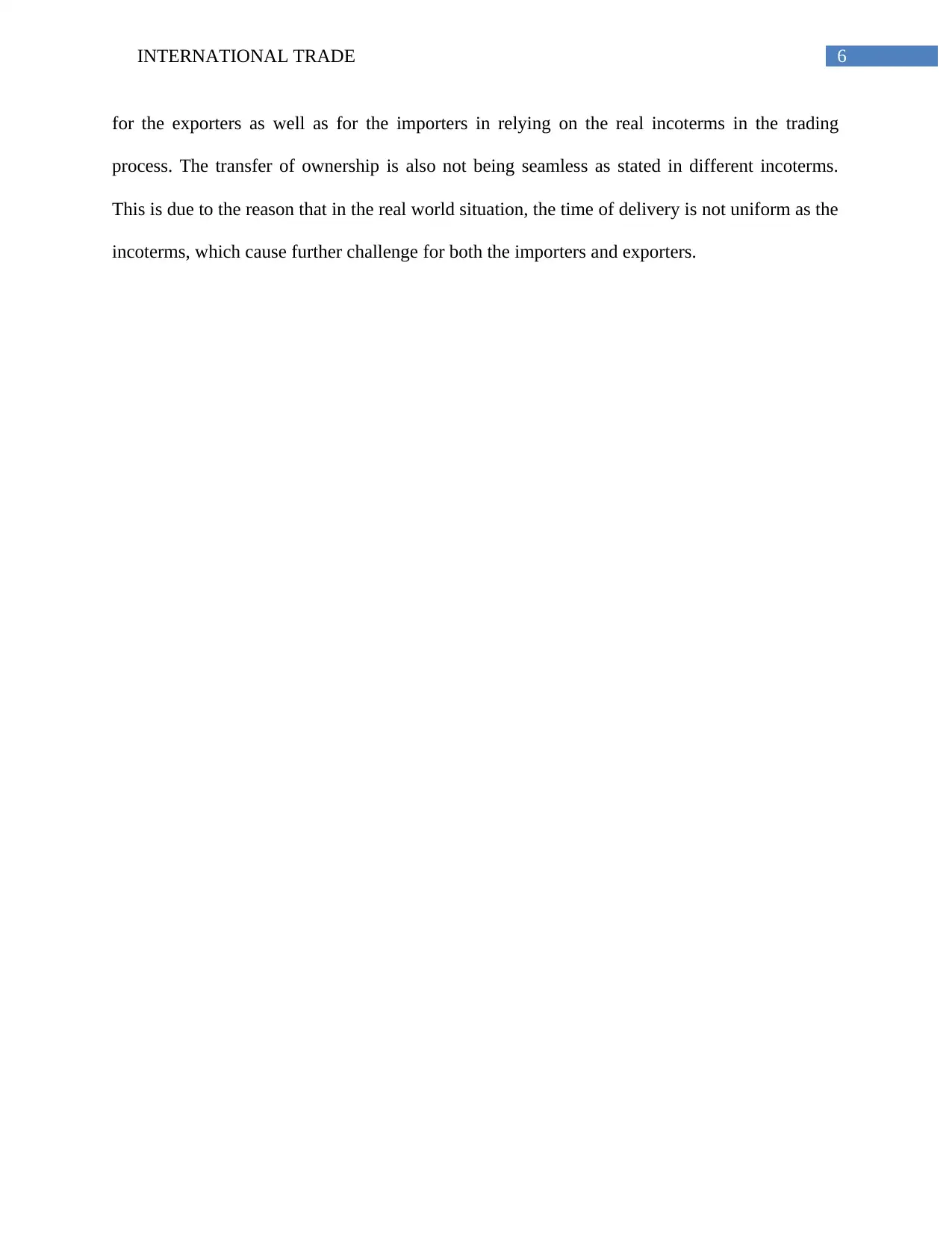
6INTERNATIONAL TRADE
for the exporters as well as for the importers in relying on the real incoterms in the trading
process. The transfer of ownership is also not being seamless as stated in different incoterms.
This is due to the reason that in the real world situation, the time of delivery is not uniform as the
incoterms, which cause further challenge for both the importers and exporters.
for the exporters as well as for the importers in relying on the real incoterms in the trading
process. The transfer of ownership is also not being seamless as stated in different incoterms.
This is due to the reason that in the real world situation, the time of delivery is not uniform as the
incoterms, which cause further challenge for both the importers and exporters.
Paraphrase This Document
Need a fresh take? Get an instant paraphrase of this document with our AI Paraphraser
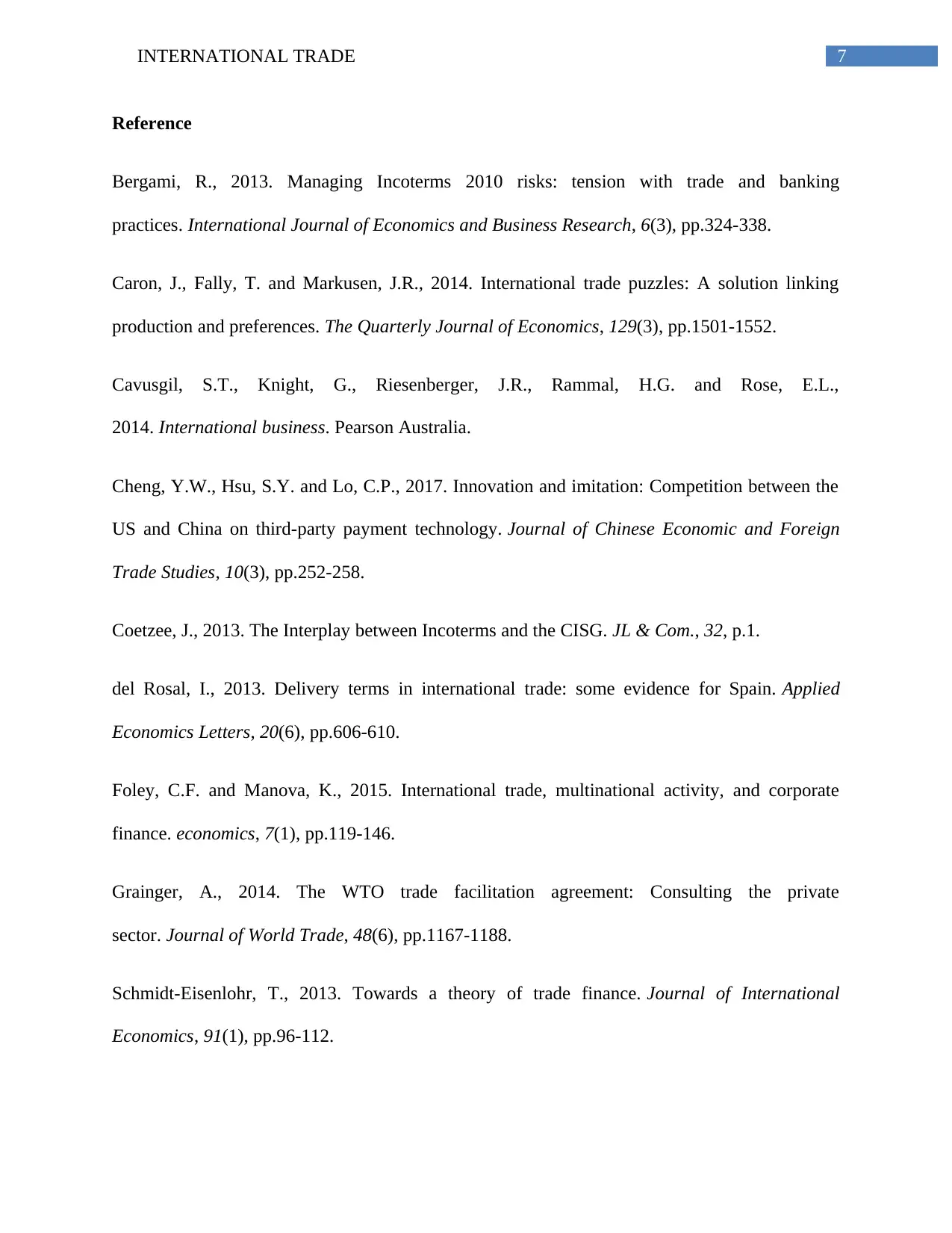
7INTERNATIONAL TRADE
Reference
Bergami, R., 2013. Managing Incoterms 2010 risks: tension with trade and banking
practices. International Journal of Economics and Business Research, 6(3), pp.324-338.
Caron, J., Fally, T. and Markusen, J.R., 2014. International trade puzzles: A solution linking
production and preferences. The Quarterly Journal of Economics, 129(3), pp.1501-1552.
Cavusgil, S.T., Knight, G., Riesenberger, J.R., Rammal, H.G. and Rose, E.L.,
2014. International business. Pearson Australia.
Cheng, Y.W., Hsu, S.Y. and Lo, C.P., 2017. Innovation and imitation: Competition between the
US and China on third-party payment technology. Journal of Chinese Economic and Foreign
Trade Studies, 10(3), pp.252-258.
Coetzee, J., 2013. The Interplay between Incoterms and the CISG. JL & Com., 32, p.1.
del Rosal, I., 2013. Delivery terms in international trade: some evidence for Spain. Applied
Economics Letters, 20(6), pp.606-610.
Foley, C.F. and Manova, K., 2015. International trade, multinational activity, and corporate
finance. economics, 7(1), pp.119-146.
Grainger, A., 2014. The WTO trade facilitation agreement: Consulting the private
sector. Journal of World Trade, 48(6), pp.1167-1188.
Schmidt-Eisenlohr, T., 2013. Towards a theory of trade finance. Journal of International
Economics, 91(1), pp.96-112.
Reference
Bergami, R., 2013. Managing Incoterms 2010 risks: tension with trade and banking
practices. International Journal of Economics and Business Research, 6(3), pp.324-338.
Caron, J., Fally, T. and Markusen, J.R., 2014. International trade puzzles: A solution linking
production and preferences. The Quarterly Journal of Economics, 129(3), pp.1501-1552.
Cavusgil, S.T., Knight, G., Riesenberger, J.R., Rammal, H.G. and Rose, E.L.,
2014. International business. Pearson Australia.
Cheng, Y.W., Hsu, S.Y. and Lo, C.P., 2017. Innovation and imitation: Competition between the
US and China on third-party payment technology. Journal of Chinese Economic and Foreign
Trade Studies, 10(3), pp.252-258.
Coetzee, J., 2013. The Interplay between Incoterms and the CISG. JL & Com., 32, p.1.
del Rosal, I., 2013. Delivery terms in international trade: some evidence for Spain. Applied
Economics Letters, 20(6), pp.606-610.
Foley, C.F. and Manova, K., 2015. International trade, multinational activity, and corporate
finance. economics, 7(1), pp.119-146.
Grainger, A., 2014. The WTO trade facilitation agreement: Consulting the private
sector. Journal of World Trade, 48(6), pp.1167-1188.
Schmidt-Eisenlohr, T., 2013. Towards a theory of trade finance. Journal of International
Economics, 91(1), pp.96-112.
1 out of 8
Related Documents
Your All-in-One AI-Powered Toolkit for Academic Success.
+13062052269
info@desklib.com
Available 24*7 on WhatsApp / Email
![[object Object]](/_next/static/media/star-bottom.7253800d.svg)
Unlock your academic potential
Copyright © 2020–2025 A2Z Services. All Rights Reserved. Developed and managed by ZUCOL.





